REGION
Changing Political Narratives
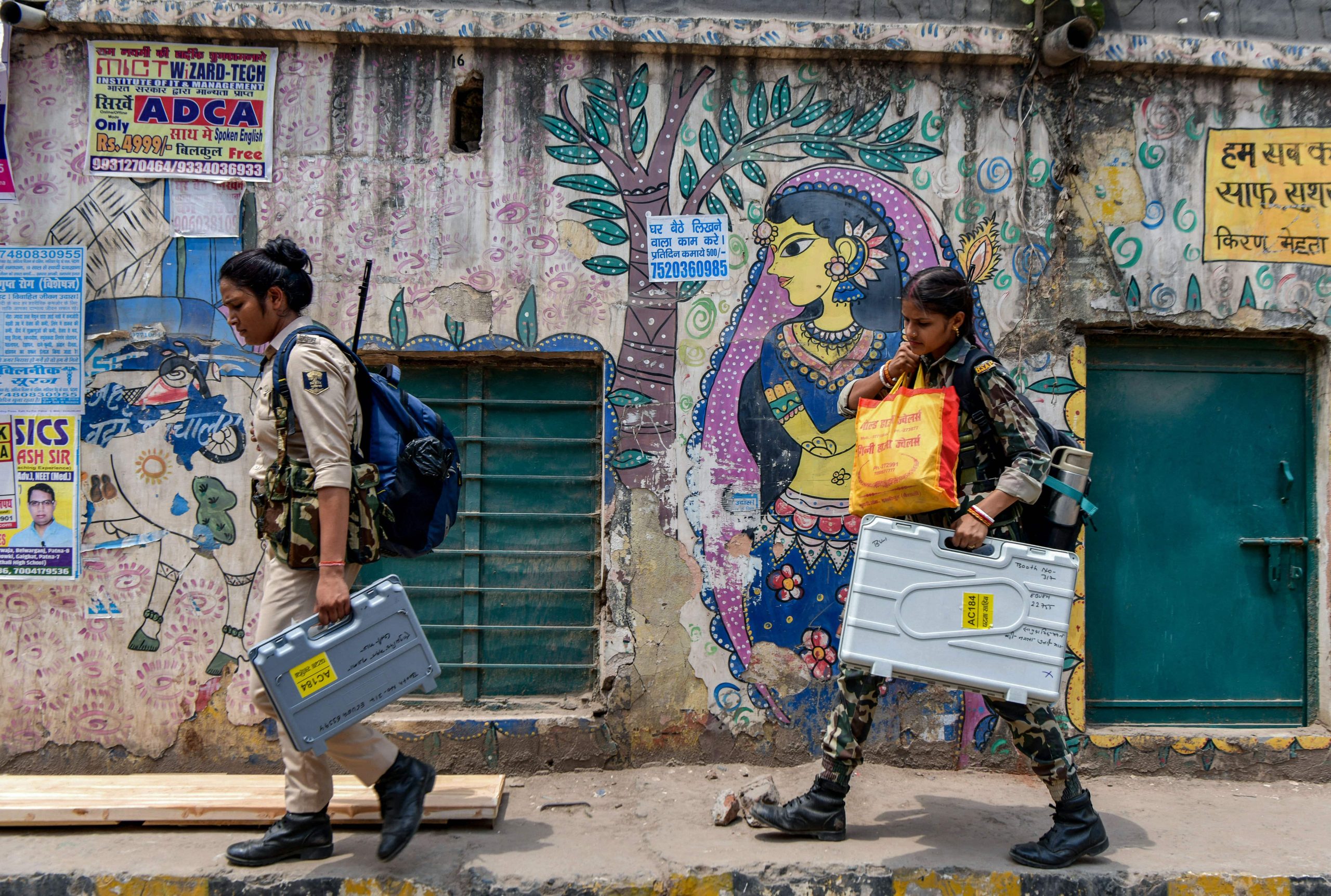
The role of the media as a watchdog took a beating in the world’s largest democracy, with mainstream media frequently accused of promoting government narratives and failing to provide critical coverage of electoral processes. Security personnel carry Electronic Voting Machines and other voting materials as they leave for polling stations in Patna on May 31, 2024. Credit: Sachin Kumar / AFP
In the period under review, South Asia faced political turmoil, democratic backsliding, and worsening press freedom. Significant political upheavals in Sri Lanka and Bangladesh, crucial electoral processes in Bhutan, India, the Maldives, Nepal, Pakistan and Sri Lanka and another year under an authoritarian regime in Afghanistan brought to the fore the vital role of the media as a ‘watchdog’ and fourth pillar of democracy.
Elections, military interventions, and government crackdowns reshaped governance while independent journalism suffered further legal, financial and physical repression. Across the region, growing media censorship, digital control, disinformation driven by Artificial Intelligence (AI) and state-backed narratives signalled a deepening crisis for both press freedom and democracy.
Key political changes were experienced in most countries of the South Asia region, with a slate of elections throughout 2024. This report details the unfolding stories of these countries, starting with the two most populus electorates of India and Pakistan, followed by the monumental people’s uprising in Bangladesh and the key events that led to a major political transition in Sri Lanka.
Across the region, growing media censorship, digital control, disinformation driven by Artificial Intelligence (AI) and state-backed narratives signalled a deepening crisis for both press freedom and democracy.
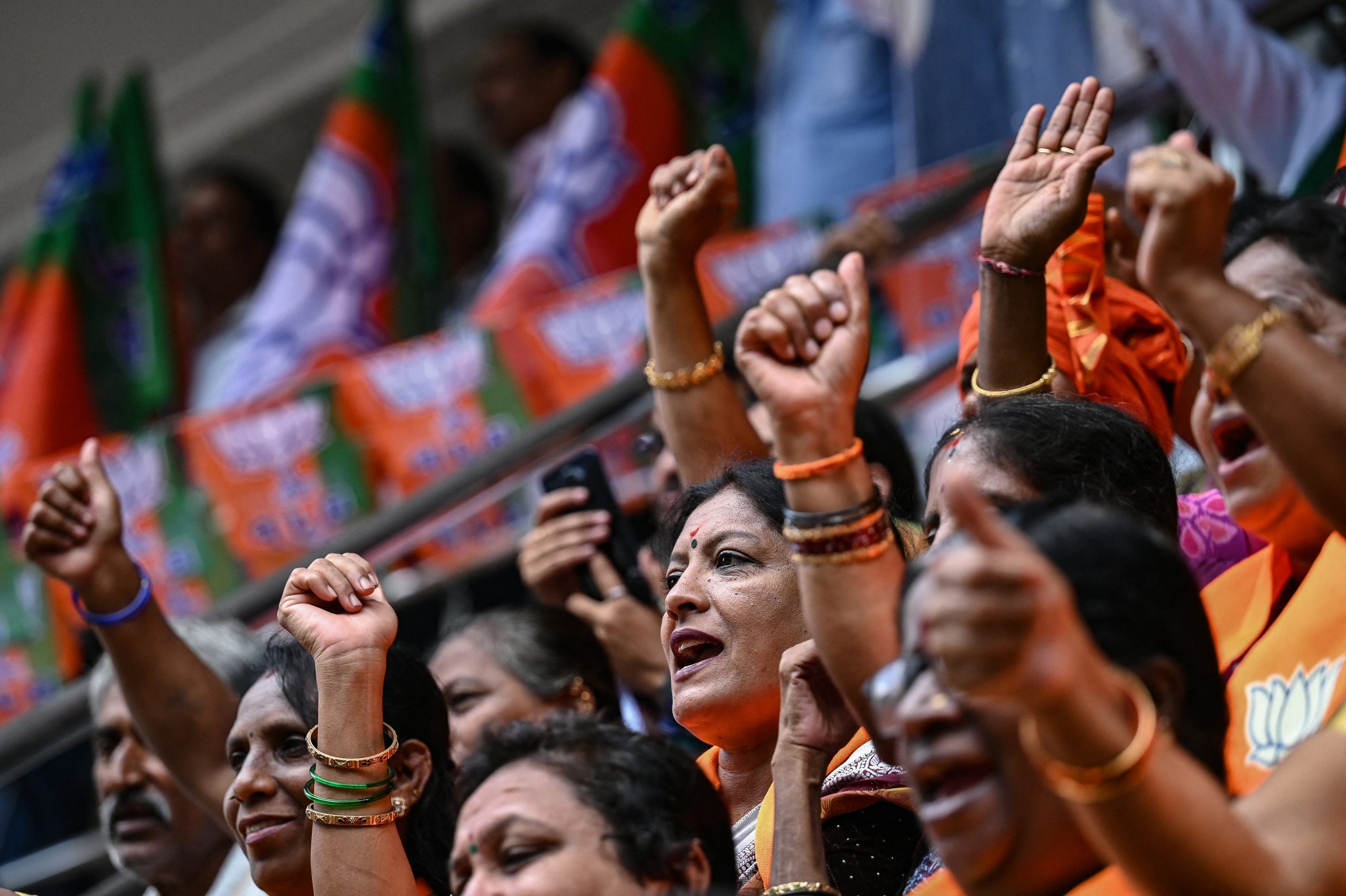
Supporters of the victorious Bharatiya Janata Party (BJP) celebrate as the country’s general election results are displayed live at the party’s office in Bengaluru on June 4, 2024. Credit: Idrees Mohammed / AFP
INDIA: Propaganda and the press
India’s political and media landscape endured significant changes and upheaval, with the 2024 general elections ultimately reducing the Bharatiya Janata Party (BJP)-led National Democratic Alliance’s (NDA) majority. Assembly elections also took place in several politically significant states.
In a noted repressive climate, some of the key digital media outlets such as The Wire, Scroll, Newslaundry, The NewsMinute, and Article 14 played an increasingly vital role in documenting and amplifying issues despite ongoing financial crackdowns and legal intimidation. Through investigative reporting, fact-checking, and grassroots-level coverage, it was independent media that continued to challenge the mainstream media’s pro-government narrative and expose electoral irregularities, helping preserve public accountability in an increasingly hostile information ecosystem.
The growing consolidation of media ownership, by industrialists closely aligned with the government over the past decade, continues to pose a grave threat to press freedom and democratic discourse.
The acquisition of Network 18 and its stable of channels and digital outlets by the Mukesh Ambani led-Reliance Industries back in 2014, was just the beginning of the downslide. Then there was the Adani Group’s 2022 takeover of New Delhi Television Limited (NDTV), once a flagship of independent news, and its infusion of INR 900 crore (USD 9 billion) into its media arm which seemed to signal a death knell for the independent electronic news media outlet. Such aggressive expansion and monopolisation by powerful business elites now threatens to convert these once robust editorial platforms into echo chambers for government-friendly narratives, undermining critical journalism, side-lining dissenting voices, reinforcing a climate of fear and self-censorship and further eroding democratic accountability.
In the period, the role of the media as a watchdog took a beating in the world’s largest democracy, with mainstream media frequently accused of promoting government narratives and failing to provide critical coverage of electoral processes.
Investigative platforms like The Reporters’ Collective lost tax exemptions, while other digital news organisations faced regulatory pressure, leading to a chilling effect on independent journalism.
Surge of disinformation
Disinformation propagated by the IT cells of various political parties has been used to manipulate narratives and employ deepfake technology to target political opponents. This troubling trend was highlighted in the World Economic Forum’s 2024 Global Risk Report which identified India as having the highest risk of misinformation and disinformation worldwide. Another study by the Indian School of Business and CyberPeace documented that social media platforms were responsible for 77 per cent of misinformation in the country, with X (formerly Twitter) accounting for 61 per cent and Facebook for 34 per cent, respectively.
The influence of “Big Tech” and social media in shaping public discourse became increasingly evident. Politicians leveraged platforms such as WhatsApp, Facebook, and X to spread propaganda, suppress opposition, and further fuel misinformation. In addition to mis/disinformation, India experienced a significant surge of hate speech incidents in the period targeting religious minorities, particularly Muslims and Christians. According to a report by the Center for the Study of Organized Hate (CSOH) released in February 2025, such incidents increased by 74 per cent in 2024. The report found that despite their own community standards prohibiting hate speech, social media platforms failed to enforce their guidelines, allowing violative content to spread unchecked in the Indian context in 2024.
The escalation of hate speech was particularly pronounced during the general election period, with political rallies and religious gatherings serving as common platforms for disseminating divisive rhetoric. High-profile figures, including national leaders, were implicated in propagating hate speech, contributing to heightened communal tensions and undermining social cohesion.
Despite the alarming rise in incidents, India is still to enact specific legislation to penalise hate speech, while the Hate Crimes and Hate Speech (Combat, Prevention And Punishment) Bill, 2022, introduced in the Upper House of Parliament in December 2022 has not been discussed with all stakeholders. This legal vacuum allows hate speech to flourish unchecked, especially when perpetrators are politically influential. Frequently, senior political leaders accused of promoting divisive rhetoric invariably invoked the right to free speech as a shield, avoiding accountability and reinforcing impunity. Such a climate continues to further embolden repeat offenders and severely undermine social harmony and democratic discourse.
Despite mounting pressures on press freedom and an overwhelming tide of state-backed disinformation, India’s independent digital media mounted a robust pushback during the 2024 elections. Fact-checking organisations such as Alt News and Boom Live, alongside influential YouTubers such as Dhruv Rathee, played a pivotal role in countering misinformation and offering critical perspectives. In a notable initiative, five independent media outlets, Newslaundry, The News Minute, The Wire, The Caravan, and Scroll, collaborated to cover the election results through audience-funded broadcasting. This innovative model of public-supported journalism underscored both the resilience and relevance of independent media amid shrinking civic space.
Digital control
India’s regulatory laws, such as the Broadcasting Services (Regulation) Bill, 2023 which is aimed at overhauling digital media regulations, have raised concerns about government overreach and potential censorship of OTT platforms and individual content creators. After a backlash from independent media, the government withdrew a revised 2024 draft only to reinstate the original 2023 version, keeping uncertainties alive over future regulatory controls.
Control over digital spaces, combined with economic and legal pressures on independent journalism, signalled a worsening crisis for press freedom and democratic accountability.
In the lead-up to the general elections, the government intensified efforts to suppress dissenting voices online. An executive order was issued to X mandating the takedown of posts critical of the government and blocking of accounts, including those of journalists, that challenged official narratives. The move drew criticism from digital rights groups as a blatant violation of free speech and democratic norms. Meanwhile, X has taken the Government of India to court, alleging that its SAHYOG portal, set up as a coordinated effort to fight cybercrime is actually a “censorship portal” that allows local police and different parts of the government to indiscriminately demand takedowns of online content. The portal was originally conceptualised to be a platform that would facilitate coordination among law enforcement agencies, social media platforms and telecom service providers to help in quicker takedowns of unlawful content. Yet media outlets have called on the government to provide the full details of the features of the SAHYOG portal for public perusal to ensure that it does not bypass the legal frameworks for online content regulation.
Fact-checking organisations such as Alt News and Boom Live, alongside influential YouTubers such as Dhruv Rathee, played a pivotal role in countering misinformation and offering critical perspectives.
An executive order was issued to X mandating the takedown of posts critical of the government and blocking of accounts, including those of journalists, that challenged official narratives.
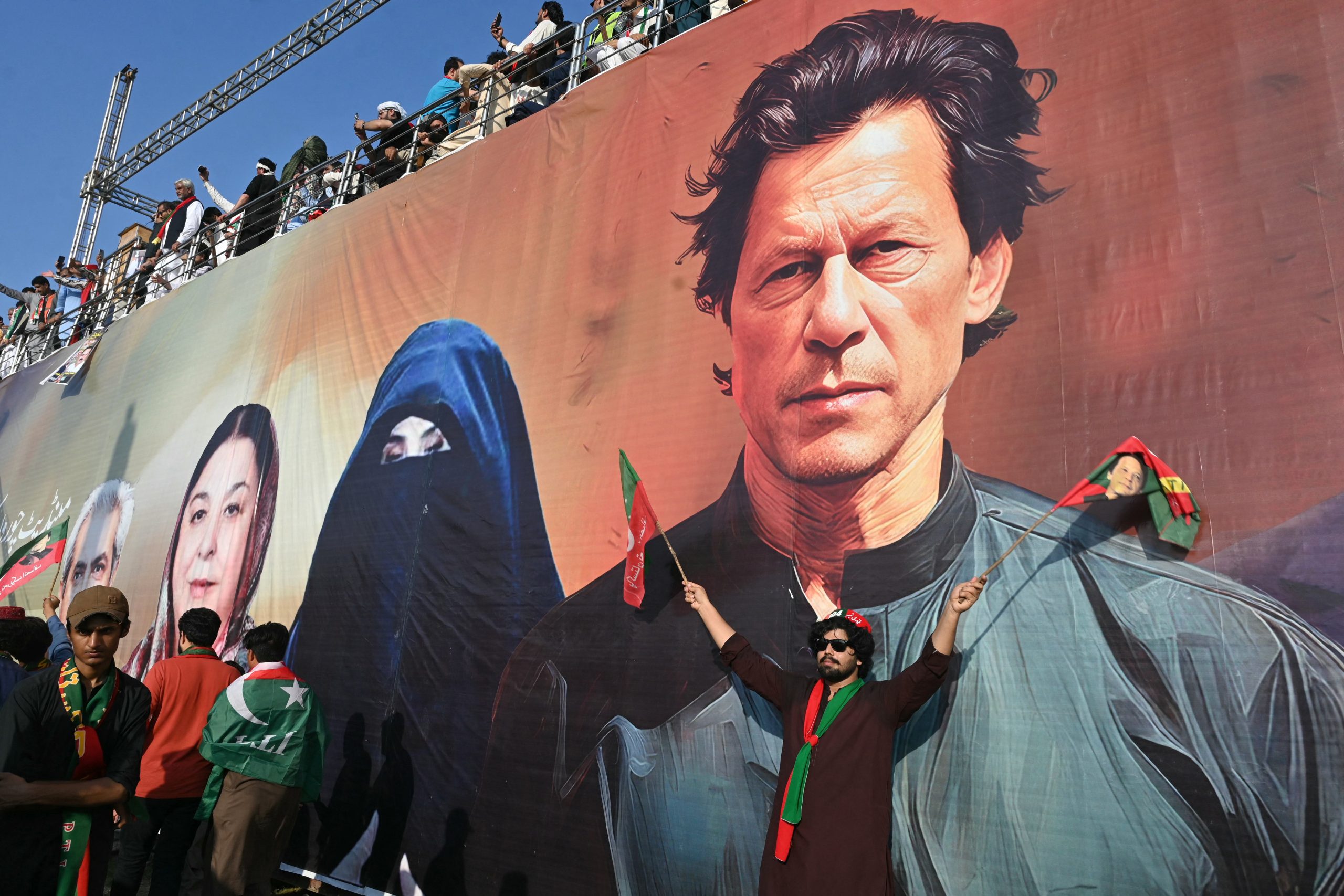
When a post-election alliance brought to power two parties in Pakistan that had won fewer seats individually, the opposition Pakistan Tehreek-e-Insaf (PTI) took to the streets in months long, and often violent agitations. Supporters of jailed former Prime Minister Imran Khan take part in a rally on the outskirts of Islamabad on September 8, 2024. Credit: Farooq Naeem / AFP
PAKISTAN: Military overreach and democratic challenges
Pakistan continued to face instability, military interference, and press repression amid a political mire and social unrest following the February 2024 elections.
After Pakistan Tehreek-e-Insaf (PTI) candidates were barred from contesting under the party’s electoral symbol due to legal challenges and the party’s deregistration by the Election Commission of Pakistan, PTI-affiliated politicians contested as independent candidates. Yet while these independents won 93 seats, making them the largest single bloc, they still lacked formal party status in the National Assembly. A technicality upheld by the court denied their claim over reserved seats, leaving them short of a majority.
In contrast, the Pakistan Muslim League-Nawaz (PML-N) and Pakistan Peoples Party (PPP), the country’s two largest traditional parties, were able to form a post-election alliance. Despite winning fewer seats individually, their combined strength, bolstered by reserved seats and allied parties, enabled them to command a parliamentary majority. This then allowed the National Assembly to re-elect Shehbaz Sharif (PML-N) as Prime Minister.
In retaliation, PTI cadres and supporters took to the streets protesting against the alleged rigging and manipulation of the electoral process by the military establishment. The first of the protests were violently suppressed, leaving at least 12 dead. At the same time, the military continued to expand its control over the judiciary, enabling PTI founder chairman and former Prime Minister Imran Khan’s imprisonment and silencing the opposition.
More protests followed throughout the year. According to Carnegie Endowment’s Global Protest Tracker, there were at least at least ten significant protests in the country from May 2024 to March 2025 on various issues related to controversial legal amendments, banning of social movements, education policy, military plans against extremist movements, deadly militant attacks, blasphemy charges and the arrest of Imran Khan.
In January 2025, despite widespread and ongoing protests calling for his release, a Pakistani court sentenced Khan to 14 years in jail after finding him guilty of corruption.
Increased military influence in politics also saw anti-democratic moves such as the 26th Constitutional Amendment in October 2024, further undermining judicial independence by amending the procedure of appointments of judges, and amendments to the Prevention of Electronic Crimes Act (PECA) a month later. The latter criminalised disinformation, especially online speech deemed “anti-state” or “against national security” and also increased state surveillance. Journalists also faced mass arrests, torture, and targeted killings.
The use of AI in Pakistan’s political sphere is well-documented with both PTI and military-backed digital teams engaging in AI-generated propaganda and disinformation campaigns. PTI is becoming extremely adept at employing AI-generated content, such as speeches and videos, to circumvent censorship and rally supporters, including a fake victory speech by former PM, Imran Khan, which spread confusion. A TRT World Research Centre report noted PTI’s use of AI-powered virtual rallies, claiming over five million views despite internet disruptions.
Pakistan’s social media penetration is 66.9 million users as of January 2024, or approximately 26 per cent of the total population, according to DataReportal. The Pakistan Telecommunication Authority (PTA) figures dated only from 2023 put the telecom penetration rate in the country at 81 per cent. The history of misinformation suggests fertile ground for AI-driven propaganda.
Elections and political turmoil
The country’s marred general elections, widely criticised for being rigged allegedly by the military-led deep state, set the political tone for the year under review.
Civil society organisations, independent media, and opposition parties cited pre-election arrests of (PTI) leaders, restricted media coverage, and allegations of vote tampering as key issues of concern. The Election Commission of Pakistan was also accused of bias, particularly for withholding reserved seats for women and minorities from the PTI-backed Sunni Ittehad Council.
Pakistan witnessed a sharp rise in repression of dissent during the reporting period. According to Amnesty International, 4,000 PTI supporters were detained by the police ahead of a massive national protest by the party in November 2024. Another report claimed at least 1,000 people were arrested on the day of the protest march. However, a fact-finding mission of the Human Rights Commission of Pakistan found it challenging to corroborate the accounts and testimonies of families, the government, the PTI, and journalists.
The Commission of Inquiry on Enforced Disappearances reported having registered 379 new cases of missing persons in 2024. Investigative journalist Matiullah Jan was arrested in November 2024 under terrorism and narcotics charges, widely seen as retribution for critical reporting. In March 2025, prominent woman activist Mahrang Baloch was jailed following protests over disappearances in Balochistan.
Digital repression and narrative controls
The government intensified digital repression through a series of restrictive measures, including the January 2025 amendments to the PECA act which granted sweeping powers to imprison social media users for alleged “false information”. An earlier February 2024 dictate to block X nationwide, on the basis of protecting national security, remains in place. In November 2024, a VPN ban was proposed, justified under “Islamic laws”, to prevent the circumvention of internet restrictions. These actions severely curtailed digital freedoms, limiting access to independent news, encrypted communication, and real-time political discourse, further tightening the government’s control over online spaces.
The ongoing tensions between digital platforms and governmental regulations in Pakistan have been evident in the government’s periodic bans of social media platforms in the past. Between 2020 and 2021, the government imposed and lifted four bans on TikTok, citing concerns over immoral and indecent content.
In response to the proliferation of disinformation, various social media platforms implemented fact-checking measures. For instance, TikTok launched the Pakistan Election Center, a dedicated hub directing users to authoritative election information, aiming to combat misinformation and uphold election integrity. Despite these efforts, the effectiveness of fact-checking initiatives remained limited. Moreover, the government’s resistance to independent verification undermined these measures.
However, in the period under review, some positive efforts pushed back against disinformation in Pakistan. The US Consulate in Lahore funded training for journalists on digital verification and UNESCO held consultations to introduce the Guidelines for the Governance of Digital Platforms towards fostering conducive environment for public discourse on freedom of expression and access to information online.
Digital rights activists (e.g., Bolo Bhi, Bytes for All, and Digital Rights Foundation) led cyber-safety and counter-misinformation work, while independent journalists increasingly used YouTube to bypass censorship. Though limited in reach, these efforts marked important resistance to the state’s narrative control and contributed to preserving online civic space despite increasing authoritarian pressures.
PTI is becoming extremely adept at employing AI-generated content, such as speeches and videos, to circumvent censorship and rally supporters.
PTI is becoming extremely adept at employing AI-generated content, such as speeches and videos, to circumvent censorship and rally supporters.
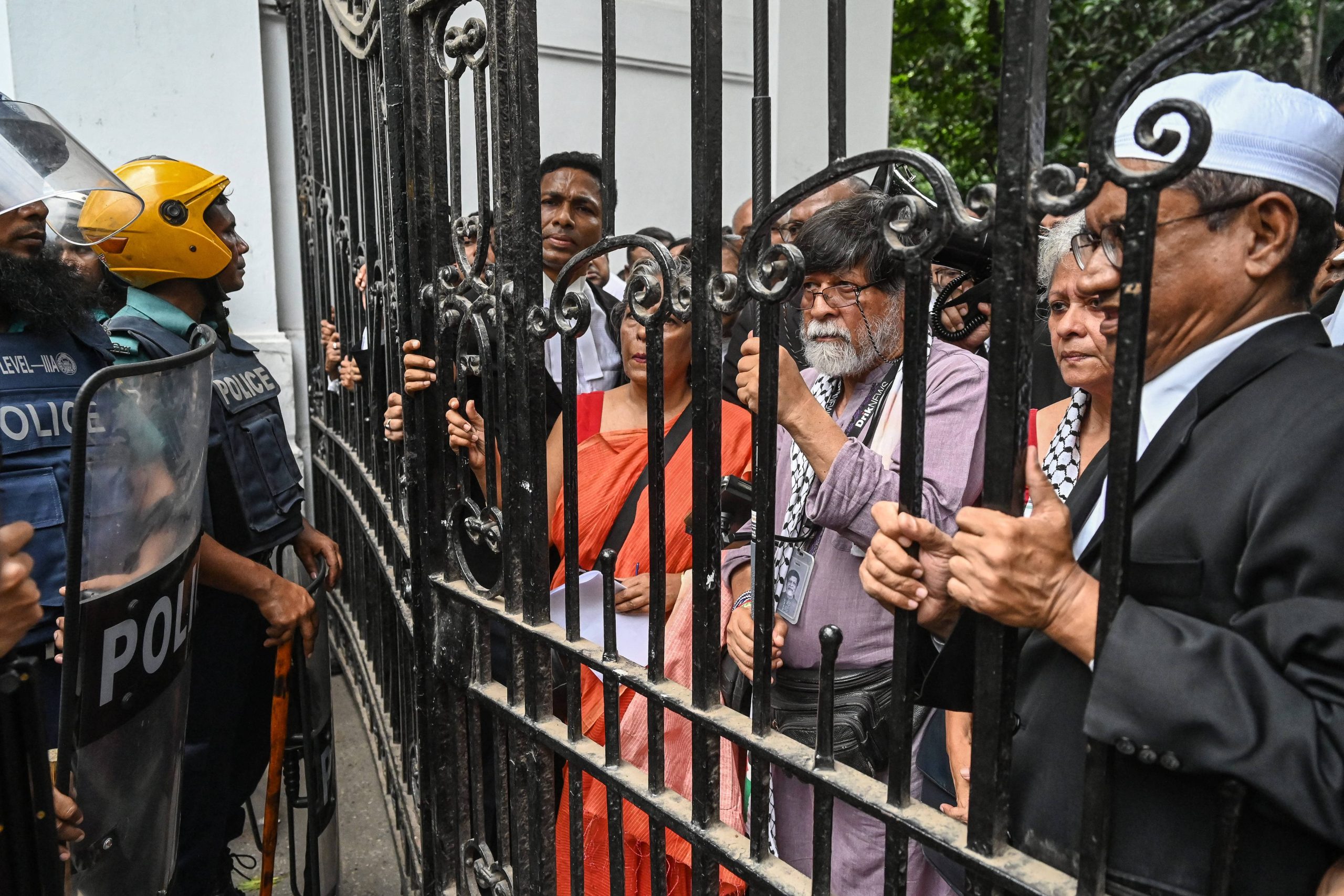
Bangladesh’s media was systematically controlled and suppressed during mass protests in 2024, preventing journalists from reporting the full story. Bangladeshi photojournalist Shahidul Alam (centre) stands alongside advocates at a High Court building gate in Dhaka on July 31, 2024, during a protest demanding justice for the victims arrested and killed in the nationwide violence. Credit: Munir Uz Zaman / AFP
BANGLADESH: Mass uprising
During the reporting period, Bangladesh faced political turmoil marked by contested elections, mass protests, military intervention, press suppression and the ouster of its long-serving prime minister.
The January 2024 elections, boycotted by the Bangladesh Nationalist Party (BNP), had already seen the ruling Sheikh Hasina-led Awami League secure a fourth consecutive term in a largely uncontested race. This was little surprise given that leading up to the vote, Hasina’s government intensified its crackdown on dissent, jailing opposition leaders and using laws like the Cyber Security Act to stifle criticism.
International observers criticised the elections for lacking transparency and a level playing field for all parties. With it, press freedom further deteriorated, and journalists attacked, arrested, and censored. Religious minorities in Bangladesh faced violence, and AI-driven disinformation campaigns further distorted public discourse and media independence. The year highlighted the fragility of Bangladesh’s democratic institutions, with the media frequently caught in the crossfire of political struggles.
By mid-year, Hasina’s iron grip on leadership was faltering and her repressive tactics triggered nationwide uprisings. Widespread discontent over alleged election rigging and economic grievances fuelled mass protests, particularly among students.
The student-led protests in mid-2024, initially sparked by opposition to a discriminatory public sector job quota system, escalated into nationwide demonstrations against the Hasina government. The full-fledged uprising calling for democratic reforms was met with brute force, leading to violent clashes and violent crackdowns by security forces, including the use of live ammunition. Some reports indicate that at least 215 protesters were killed, but independent investigations estimate the figure to be as high as 1,400 deaths. As unrest intensified in August 2024 and protesters stormed government buildings, the military intervened, propelling the 76-year-old prime minister to resign and flee to India. Nobel laureate Muhammad Yunus was appointed interim leader, tasked with restoring order and facilitating democratic reforms.
Media suppression
The Hasina government has long been widely condemned for its aggressive attacks on the media, including arbitrary detentions and financial harassment of journalists. Independent media outlets, as a means to survival, have been forced into self-censorship, fearing government retaliation. Under Hasina’s leadership, countless journalists fled the country to escape persecution, leaving the country’s already fragile press landscape further weakened.
Media workers in Bangladesh suffered immensely during the past year. Journalists covering the protests faced violent attacks, with at least 250 media professionals injured by security forces or pro-government supporters. Tragically, several journalists were killed in the firing line by security forces. On July 18, 2024, Hasan Mehedi, a journalist with the Dhaka Times, was fatally shot while covering protests in Dhaka’s Jatrabari district. Additionally, on July 19, freelance video journalist Tahir Zaman Priyo was killed in Dhaka, and on July 18, Shakil Hossain, a correspondent for Bhorer Awaj, and Abu Taher Md Turab, a reporter for the Daily Naya Diganta, were both shot dead in Sylhet.
Despite the dramatic change in government from the authoritarian rule of Sheikh Hasina, media suppression has persisted. Between October and November 2024, the Press Information Department revoked the accreditation of 167 journalists without clear justification, sparking outrage among the press freedom advocates. Notably, many of these journalists had previously covered the Prime Minister’s Office and the Awami League, leading to concerns that the mass terminations were politically motivated.
Growing polarisation
In the wake of initial optimism surrounding Yunus’s appointment, concerns have emerged regarding the legitimacy of the interim government. Civil society groups called for immediate elections to secure broader public support. Additionally, reports surfaced of a growing Islamist influence within the transitional administration, raising fears over threats to secularism.
The post-Hasina power vacuum also led to increased violence against members of the Hindu minority community. Attacks on Hindu communities intensified in this period, with reports of vandalism and forced displacements. The government’s inadequate response exacerbated fears of persecution while pro-government media attempted to downplay the crisis.
During the political upheavals in Bangladesh between May 2024 and March 2025, social media emerged as both a mobilisation tool and a disinformation conduit.
Both the previous Awami League-led government and opposition factions reportedly employed AI-driven propaganda to manipulate public opinion. For instance, deepfake videos targeting female opposition politicians, such as Rumin Farhana and Nipun Roy, were disseminated to discredit them. Additionally, misleading narratives on communal violence were propagated online, with exaggerated claims about attacks on Hindu communities and fabricated reports of cricketer Liton Das’s house being set ablaze, which were later debunked.
As Bangladesh navigates this transition, press freedom and democratic integrity remain under threat, with ongoing political volatility raising concerns about the country’s future.
Religious minorities in Bangladesh faced violence, and AI-driven disinformation campaigns further distorted public discourse and media independence.
Journalists covering the protests faced violent attacks, with at least 250 media professionals injured by security forces or pro-government supporters. Tragically, several journalists were killed in the firing line by security forces.
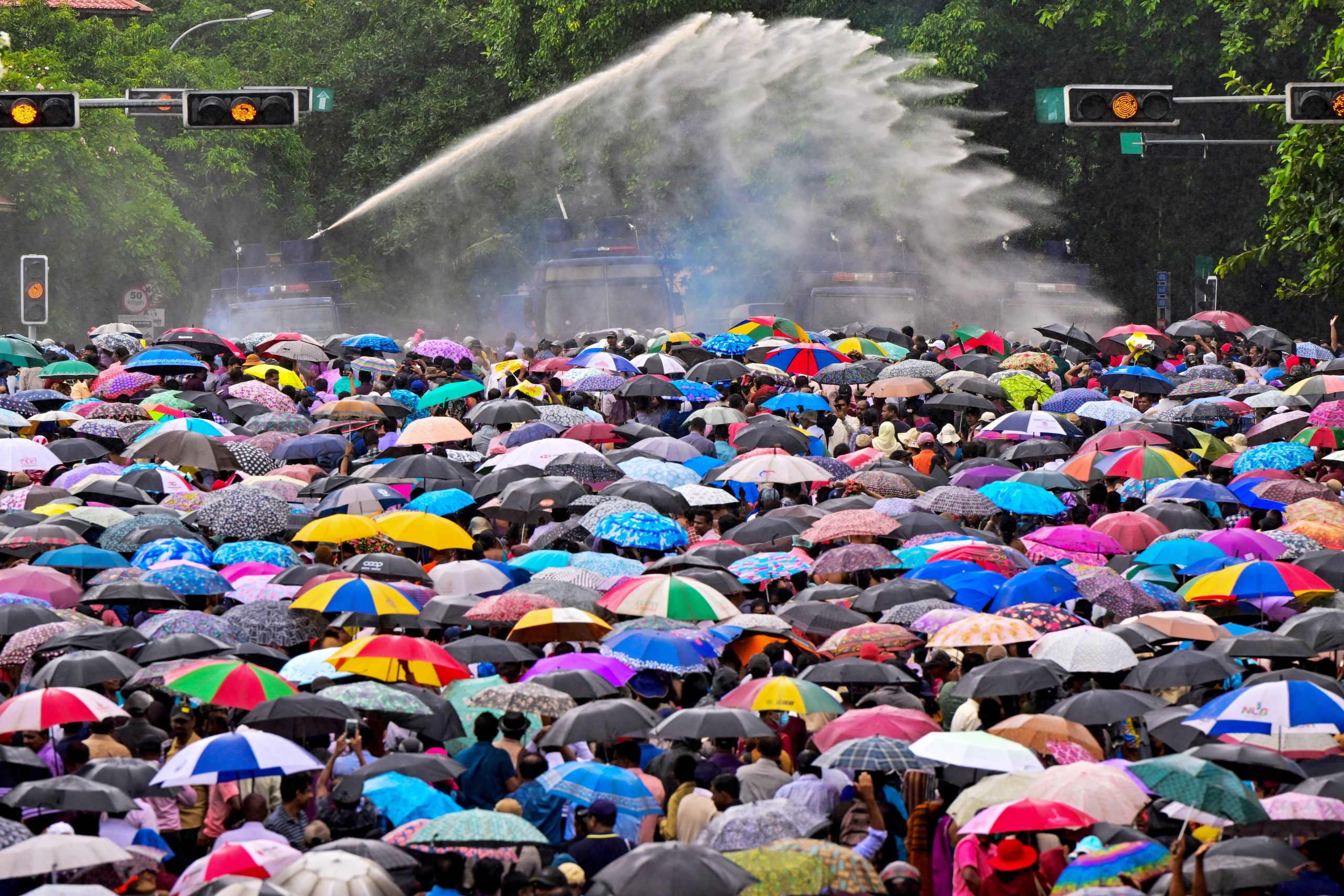
Sri Lanka grappled with economic challenges, the legacy of political dynasties, and pressing demands for institutional reform. Police use water cannons and tear gas to disperse education professionals protesting salary abuses in Colombo on June 26, 2024. Public frustration with corruption and economic mismanagement drove a significant political shift in the country’s presidential and national elections in late 2024. Credit: Ishara S. Kodikara / AFP
SRI LANKA: A much awaited transition
Sri Lanka underwent a major political shift with the victory of Anura Kumara Dissanayake of the left of centre National People’s Power (NPP) or Jathika Jana Balawegaya in the September 2024 presidential election, followed by the NPP’s landslide victory in November’s parliamentary elections. Public frustration with corruption and economic mismanagement over recent years largely drove the movement.
The elections were widely deemed free and fair, though concerns over voter education on preferential voting arose. Civil society observed that public discontent with established parties fuelled the NPP’s success, particularly its anti-corruption stance and focus on economic reform. However, despite electoral success, Sri Lanka continued to grapple with economic challenges, the legacy of political dynasties, and pressing demands for institutional reform.
The media landscape remained fraught with challenges and journalists were forced to operate in the shadow of the draconian Online Safety Act 2024 that enables censorship, mass surveillance and invades privacy. Independent media continued to struggle to operate freely, often facing legal intimidation and government influence over narratives.
The NPP’s rise presented both opportunities and risks for press freedom. While President Dissanayake pledged media independence, concerns arose over potential overreach and state co-optation of media institutions.
Social media played a crucial role in shaping public discourse but also served as a platform for disinformation. Both government aligned and opposition groups are known to use AI-driven propaganda, complicating the information landscape. Despite efforts by social media platforms to enhance fact-checking and curb misinformation, challenges remained in ensuring accuracy without suppressing free expression.
As Sri Lanka navigated its political transition, protecting press freedom, combating misinformation, and strengthening democratic institutions remained key challenges. Independent media and civil society remained vigilant about concrete democratic progress and also tracked impunity in perpetrators of crimes against humanity, and against journalists.
In March 2025, the Sri Lankan government – possibly due to media pressure – tabled the long-suppressed Batalanda Commission Report in Parliament, addressing alleged state-sponsored human rights violations, including illegal detentions and torture, during the 1988-1990 period of civil unrest. Likewise, pressure from journalists’ unions resulted in the Attorney General revoking his January 2025 release of three suspects detained in connection with the 2009 assassination of journalist Lasantha Wickrematunge.
Despite electoral success, Sri Lanka continued to grapple with economic challenges, the legacy of political dynasties, and pressing demands for institutional reform.
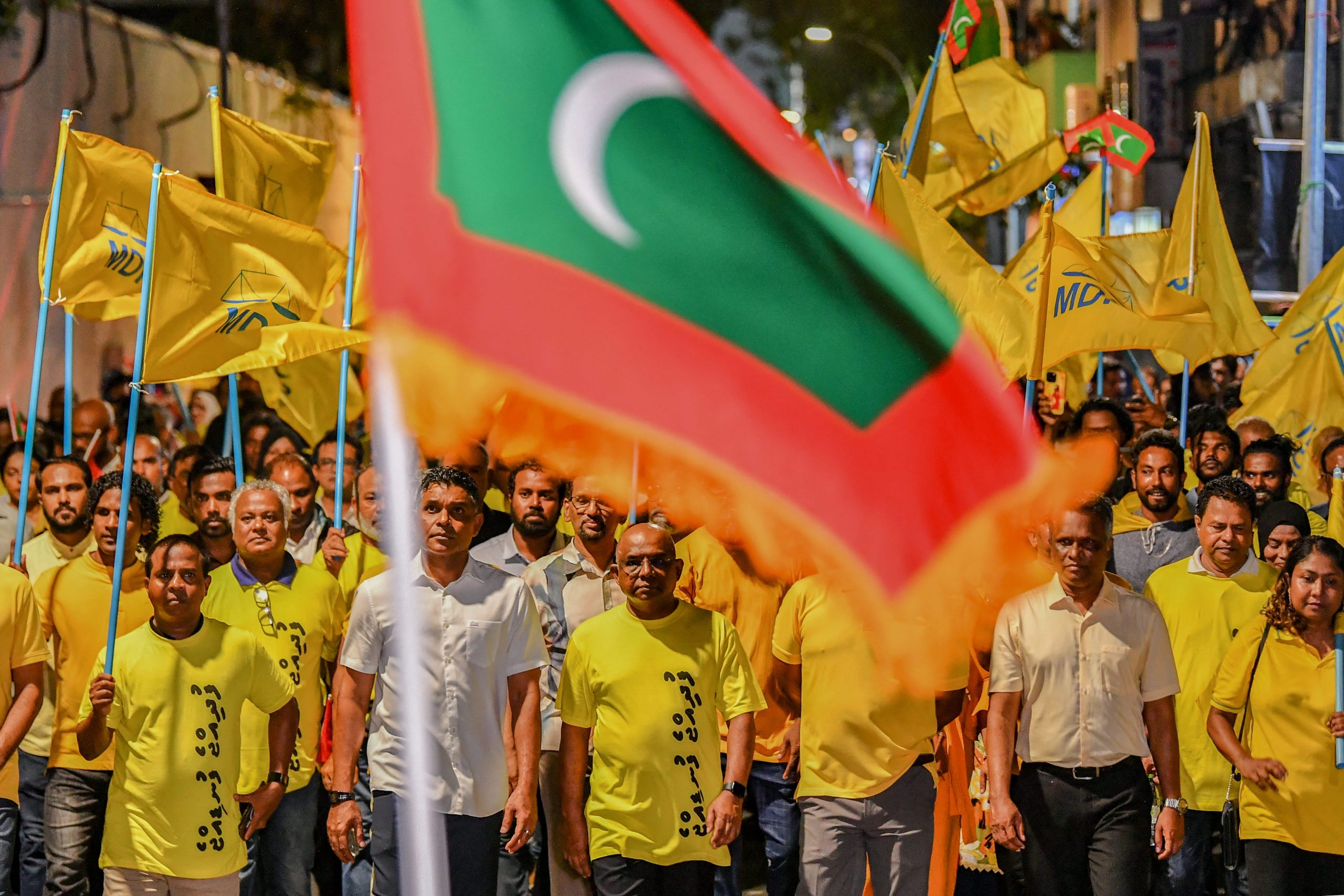
The Maldives’ shifting political landscape, combined with mounting media restrictions, signalled concern over future press freedoms and the suppression of dissenting voices. Former government ministers and members and supporters of the opposition Maldivian Democratic Party took to the streets in Malé on January 31, 2025, accusing the new government of oppressing its people. Credit: Mohamed Afrah / AFP
MALDIVES: Consolidation of power
Between May 2024 and March 2025, the Maldives underwent significant political shifts, with the media playing a crucial role in shaping democratic discourse amid increasing government control.
The January 2024 parliamentary elections saw a landslide victory for the People’s National Congress (PNC), led by President Mohamed Muizzu. This supermajority allowed the PNC to amend the constitution unopposed, strengthening its pro-China stance and reversing the previous administration’s pro-India policies. Allegations of vote-buying and undue influence surfaced, but international observers found no major irregularities.
The evolution of the media landscape in the Maldives has gone hand in hand with the birth of democracy in the atoll nation, ever since the first independent magazines and newspapers were registered along with the registration of political parties for the first time back in 2005.
But too frequently a weakened opposition in the Maldivian Parliament has often meant a lack of checks to legislative overreach, with the media being tasked with a heightened watch-dog role to flag excesses by a government armed with unchecked power. Press freedom advocates feared there would be nothing standing in their way if the ruling party wished to once again curtail freedom of expression or clamp down on unfriendly coverage as it did under the dictatorial rule of former president, Abdulla Yameen from 2013 to 2018 and the 30-year rule of Maumoon Abdul Gayoom from 1978 to 2008.
In the period under review, press freedom in the atoll nation remained constrained, with independent media facing self-censorship, blocking of websites, economic limitations due to dependence on advertisements from state-owned enterprises, and political co-option due to alignment with politicians. State-aligned media dominance and vague legal restrictions further suppressed independent reporting, discouraging investigative journalism and critical discourse.
Social media was a battleground for political narratives, with both government and opposition forces deploying AI-generated disinformation. Efforts to regulate misinformation included community-led fact-checking initiatives, but their effectiveness remained limited due to low digital literacy. The Maldives’ shifting political landscape, combined with mounting media restrictions, signalled growing concerns over future press freedoms and the suppression of dissenting voices.
In 2024, the President’s Office submitted 75 complaints to the Maldives Media Council (MMC) alleging the spread of false information by media outlets. Additionally, the government exerted pressure on the MMC to rescind an investigative journalism award granted to the documentary ‘Skeelan’, which exposed sensitive issues related to the President’s family. During this time, the Maldives witnessed the government’s concerted efforts to suppress dissenting voices and control the media landscape.
Too frequently a weakened opposition in the Maldivian Parliament has often meant a lack of checks to legislative overreach, with the media being tasked with a heightened watch-dog role.
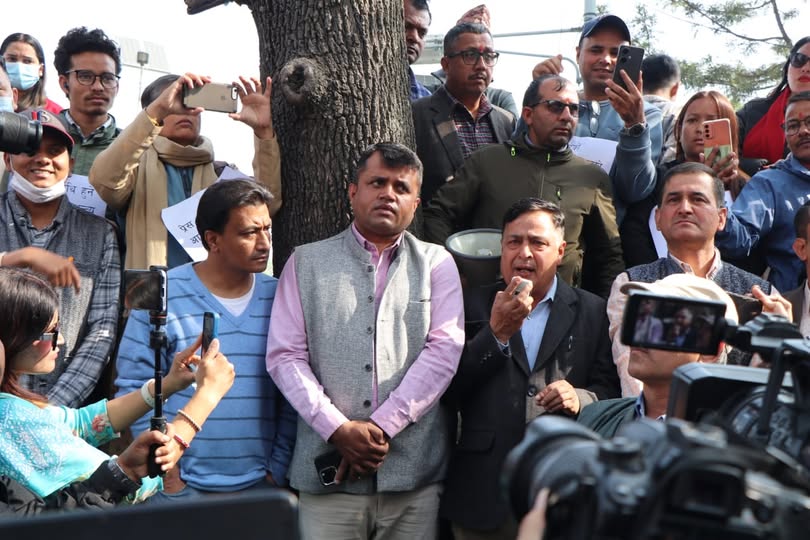
Members of the Federation of Nepali Journalists (FNJ) protest on March 30, 2025, against the killings and attacks on journalists, and the arson and vandalism against media houses in Nepal following pro-monarchy protests in the country. Over the past year, the FNJ recorded a total of 47 incidents of press freedom violations, including the killing of two journalists. Credit: FNJ
NEPAL: A Shaky Polity
Nepal experienced political instability and media suppression in the period under review, after the elections in January 2024 led to a fragmented Parliament, with the Communist Party of Nepal-Unified Marxist-Leninist (CPN-UML), led by KP Sharma Oli, emerging as the largest party but falling short of a majority.
By July 2024, Oli formed a coalition government with the centrist Nepali Congress, marking his fourth tenure as prime minister. However, concerns arose over the ideological inconsistencies of this alliance, fuelling fears of political instability and policy stagnation. Critics argued that the alliance was more about power sharing than addressing pressing national issues, reflecting a pattern of political instability that has hindered Nepal’s development.
Various pro-monarchy forces regrouped in the period with the aim of reinstating the Hindu kingdom, claiming that “two decades of bad governance, diminishing national image and the country’s standing in foreign relations [have] made it necessary to restore the Hindu kingdom.”
The pro-monarchists called for the return of Gyanendra Shah – the last royal ruler of Nepal before the monarchy was dissolved – and demanded a constitutional monarchy with a Hindu identity. They accused several political parties, including that of Prime Minister Oli, of being corrupt and incompetent in leading the country. Large-scale protests in March were accompanied by widespread vandalism, destruction of government offices, shopping malls, media outlets and private houses. The Nepali Congress, the Communist Party of Nepal (United Marxist Leninist), the Maoist Centre, and the Communist Party of Nepal (Socialist) all strongly condemned the monarchist violence. Although the support for monarchy in Nepal has grown in recent years, the chances of the return of the monarchy remain slim within the constitutionally enshrined Republic.
Nepal’s media landscape has historically been vibrant, playing a crucial role in democratic transitions. However, during this period, it faced challenges fulfilling its watchdog role. Instances of threats, intimidation and legal pressures against journalists were reported, leading to self-censorship. Press freedom declined, with journalists facing intimidation and legal threats. An example was that of Kailash Sirohiya, the owner of Nepal’s largest news organisation, Kantipur Publications, who was arrested in May 2024 over alleged citizenship law violations, raising concerns over press freedom.
Independent journalists and media unions monitored and reported government resistance to critical coverage, highlighting the need for stronger legal protections to safeguard press freedom.
Big Tech and social media
Social media again became a key battleground narrative control while disinformation surged. The controversial 2025 Social Media Bill, which required platforms to register with the state and imposed heavy penalties for non-compliance, was heavily criticised by journalists, press freedom advocates and unions for suppressing free speech, further restricting digital freedoms, increasing surveillance, and deepening Nepal’s democratic challenges.
Both government-aligned and independent social media actors sought to influence public discourse, with political entities leveraging coordinated campaigns to suppress dissenting voices. A November 2023 ban on TikTok, justified by concerns over cybercrimes and social disharmony, was finally lifted in August 2024 following an agreement with the authorities.
Major social media platforms, including Meta and X, introduced stricter fact-checking policies, but their effectiveness was limited due to Nepal’s resource constraints. Meta replaced its third-party fact-checking program with a user-driven ‘Community Notes’ system, aligning with a broader push for minimal content moderation under the new US administration’s policies.
The spread of disinformation remained a pressing issue, exacerbated by limited digital literacy among Nepalese citizens. The Media Council Bill and the AI concept paper published in July 2024 are likely to affect the media in as yet unpredictable ways.
BHUTAN: Peaceful Transition
Bhutan navigated a period of political stability and continued its commitment to democratic processes amidst significant political and media developments. The parliamentary elections, held in two rounds in late 2023 and early 2024, resulted in the People’s Democratic Party (PDP), led by former Prime Minister Tshering Tobgay, return to power. The media played a vital role in this peaceful electoral transition, despite facing ongoing and well-documented challenges in resources and capacity.
The rise of social media as a dominant force in public discourse highlighted the need for enhanced digital literacy and robust fact-checking mechanisms in the country to safeguard the integrity of information and strengthen Bhutan’s democracy.
Use of platforms like Facebook, WeChat, WhatsApp, X, and Instagram has steadily grown. However, the spread of misinformation remains a growing concern. In response, independent media and civil society groups launched fact-checking initiatives. A Bhutan Media Foundation report highlighted the continued need for greater advocacy on social media ethics, privacy, and the security to combat digital disinformation and protect public discourse.
Various pro-monarchy forces regrouped in the period with the aim of reinstating the Hindu kingdom, claiming that “two decades of bad governance, diminishing national image and the country’s standing in foreign relations [have] made it necessary to restore the Hindu kingdom.”
The controversial 2025 Social Media Bill, which required platforms to register with the state and imposed heavy penalties for non-compliance, was heavily criticised by journalists, press freedom advocates and unions.

News media in Afghanistan are now largely forced to exist as a propaganda wing of the government. Reports are closely monitored and rejected for non-compliance with the rules of the Ministry for the Propagation of Virtue and Prevention of Vice. Ministry Deputy Mohammad Faqir Mohammadi (centre) speaks during a press conference in Kabul on August 20, 2024. Credit: Wakil Kohsar / AFP
AFGHANISTAN: Democracy dismantled
There is no debating that Taliban’s authoritarian rule has severely restricted press freedom in Afghanistan, resulting in the targeting of journalists, especially women, with arrests, violence, and censorship.
Today, the country’s independent media operate under extreme constraints, with an ongoing flow of journalists fleeing into exile across borders to neighbouring countries and beyond. In this environment, social media is both a tool for resistance and a deft tool for the Taliban’s propaganda machine, making unbiased reporting increasingly difficult and dangerous.
Since its takeover in August 2021, the Taliban’s authoritarian rule has systematically eroded democratic institutions and fundamental freedoms, particularly in targeting women and the press. Afghanistan’s once-vibrant media landscape developed over decades, has dramatically deteriorated under Taliban control. Journalists face threats, arbitrary arrests, and violence, making independent reporting nearly impossible.
Women journalists continue to be forced out of their profession due to various oppressive policies. Fortunately, some of the exiled Afghan journalists, such as those at Zan Times and The Afghan Times, continue to document human rights abuses and the situation in the country but still their lives remain under threat.
The Taliban’s censorship extends to social media to supress dissenting voices through surveillance and control. Meanwhile, journalists struggle to counter disinformation due to ongoing official and unofficial restrictions on access to information, especially for women. An increasing number of bans, including on women in state media, and on broadcasting film, music, women’s voices, and images of living beings, including animals, has severely diminished the scope of news coverage and coverage of critical issues.
Despite these challenges, Afghan journalists persist in resisting Taliban narratives. But with censorship tightening and press freedoms shrinking, the Afghan media ecosystem remains under severe threat, further marginalising independent journalism and any hope of democratic discourse.
South Asia’s political shifts
What is clear is that the period under review witnessed profound political shifts and an alarming decline in press freedom across South Asia.
State control over independent media intensified, with governments weaponising legal, financial, and regulatory mechanisms to stifle dissent, while journalists faced violence, imprisonment, and exile (please see country reports and detailed listing of violations of journalists’ rights here).
Disinformation, often AI-driven, became a primary tool for narrative control, further eroding democratic accountability. While elections in multiple countries led to political realignments, they were often marred by manipulation, military interference, and the suppression of opposition voices.
Digital censorship expanded extensively, with governments in India, Pakistan, Bangladesh, Nepal, and the Maldives tightening their grip on social media and online discourse. In Afghanistan, the Taliban’s totalitarian rule silenced independent journalism, while in Bhutan, media remained fragile, grappling with the newer dilemmas posed by misinformation.
Despite the fragility of the media landscape and new and evolving challenges, independent media continued to resist, exposing corruption, human rights abuses and electoral fraud. The survival of democracy in South Asia hinges on the protection of press freedom and the resilience of independent journalism. How that sustains is a question that the media industry continues to grapple with.
